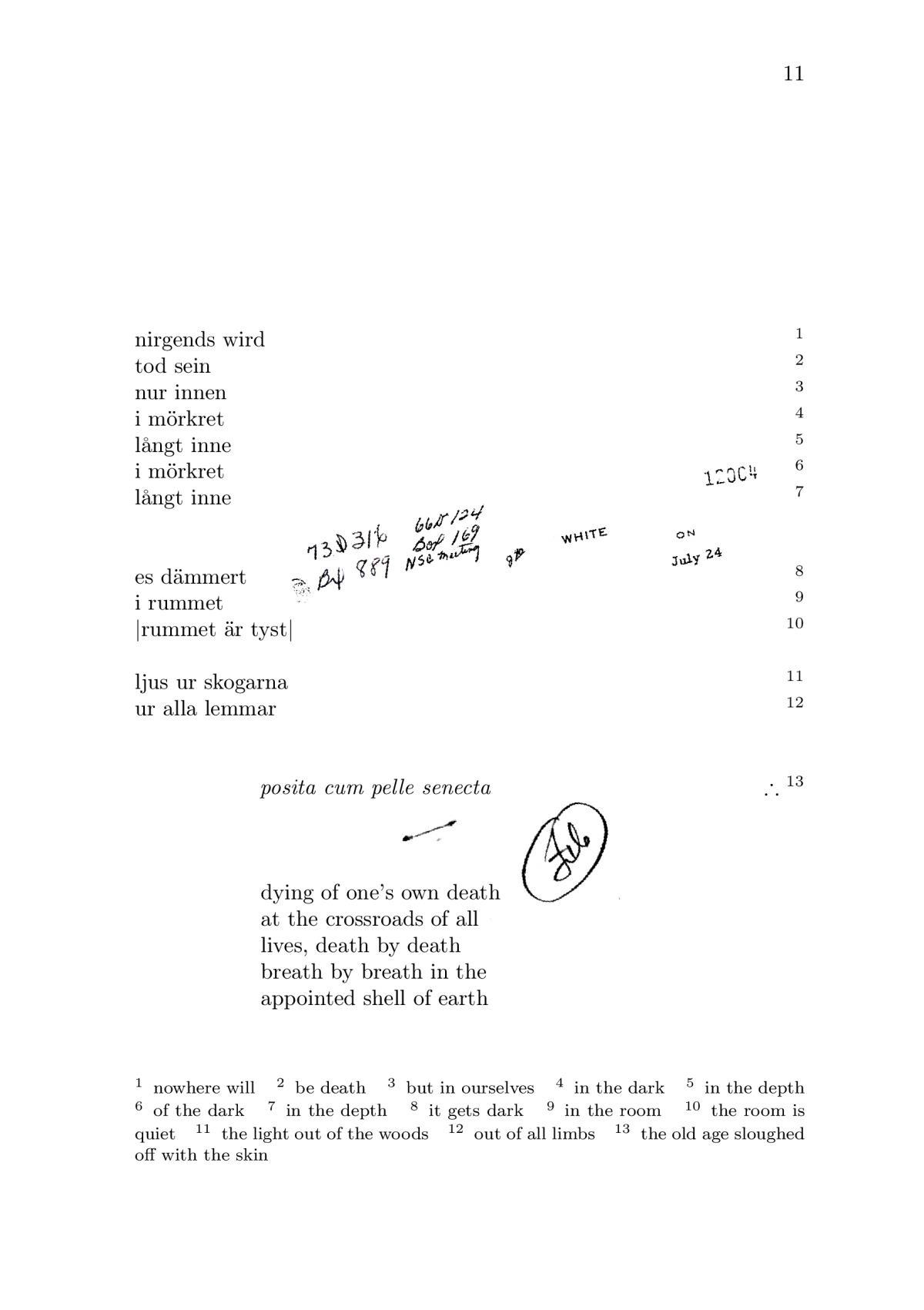
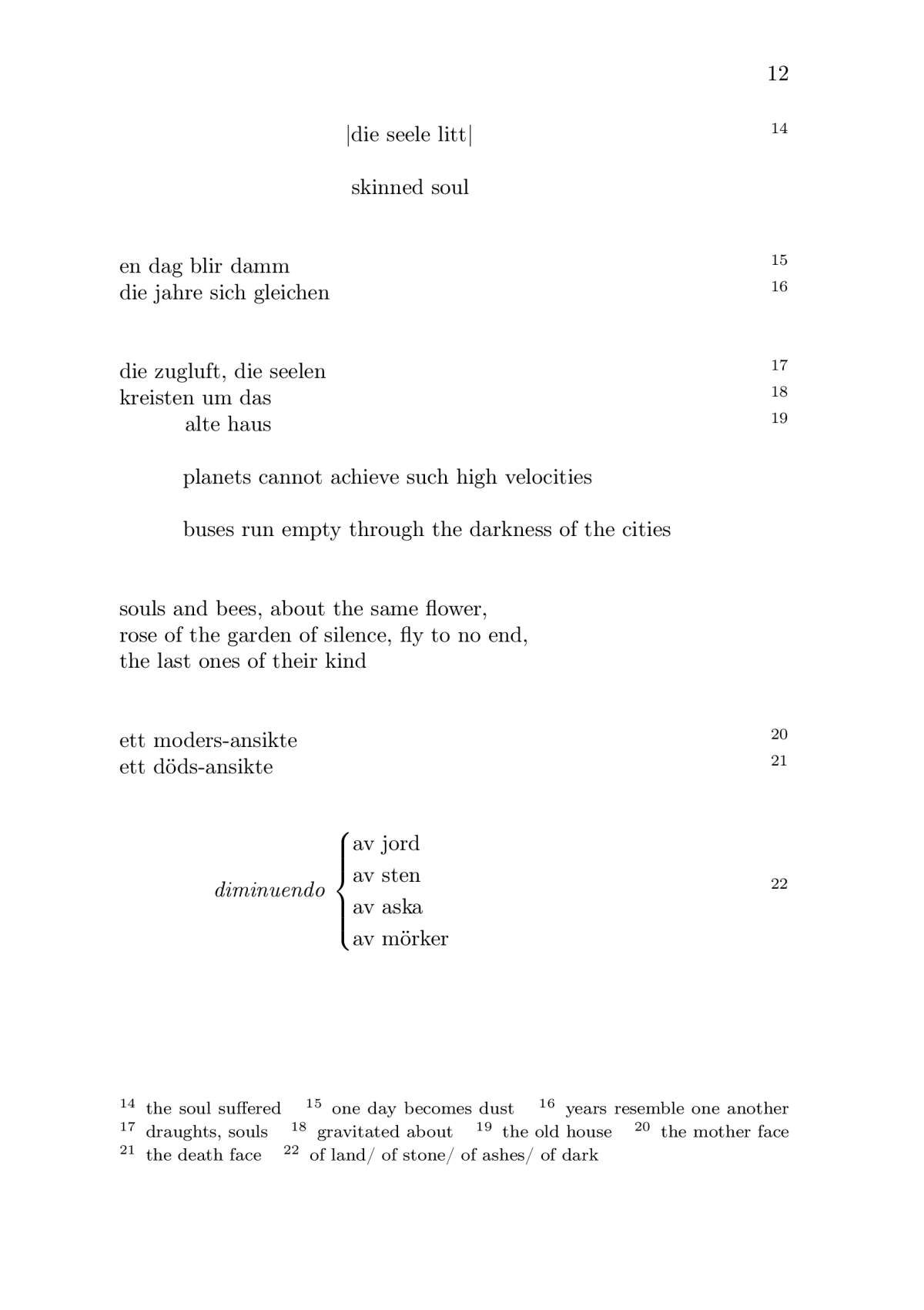
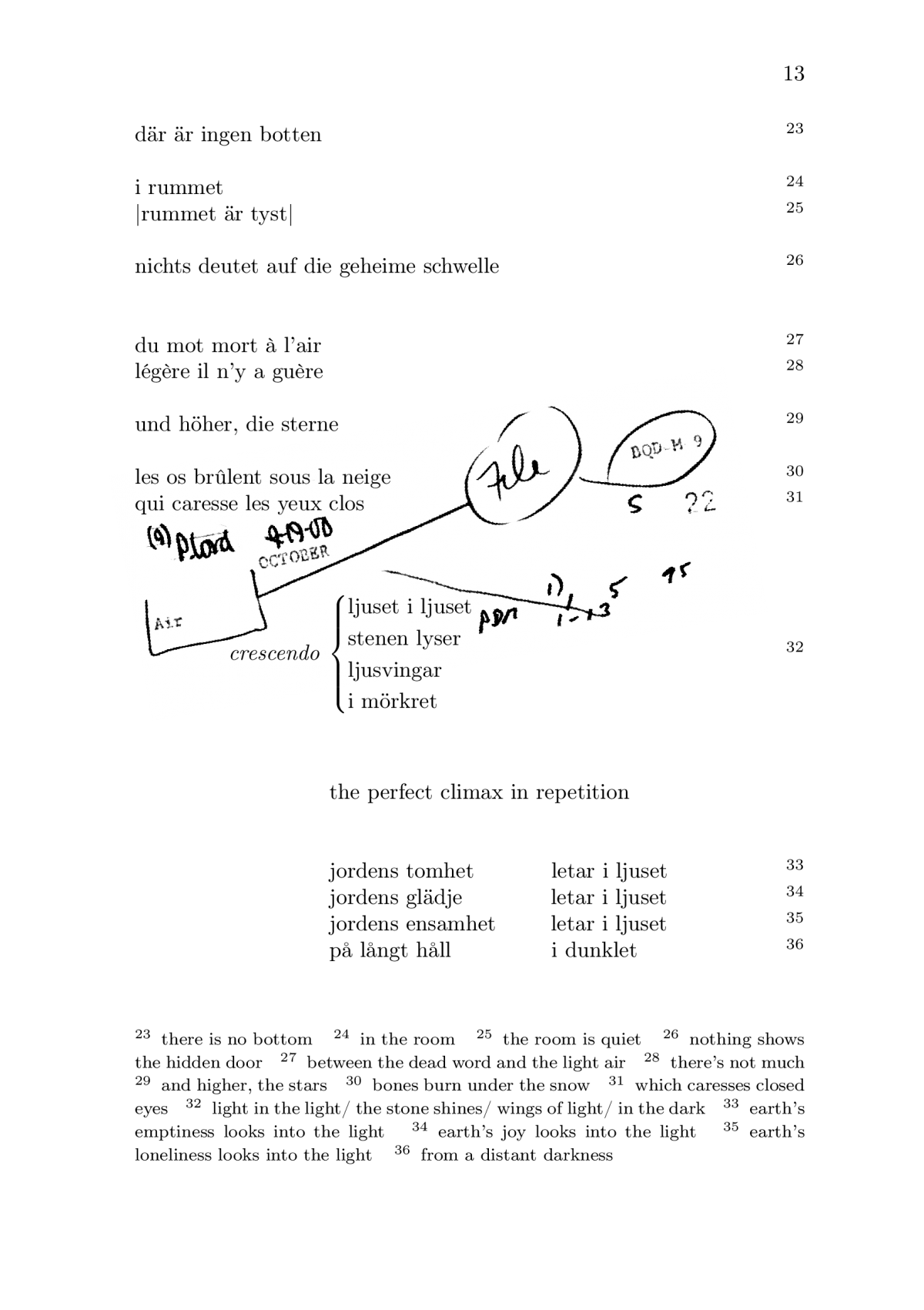
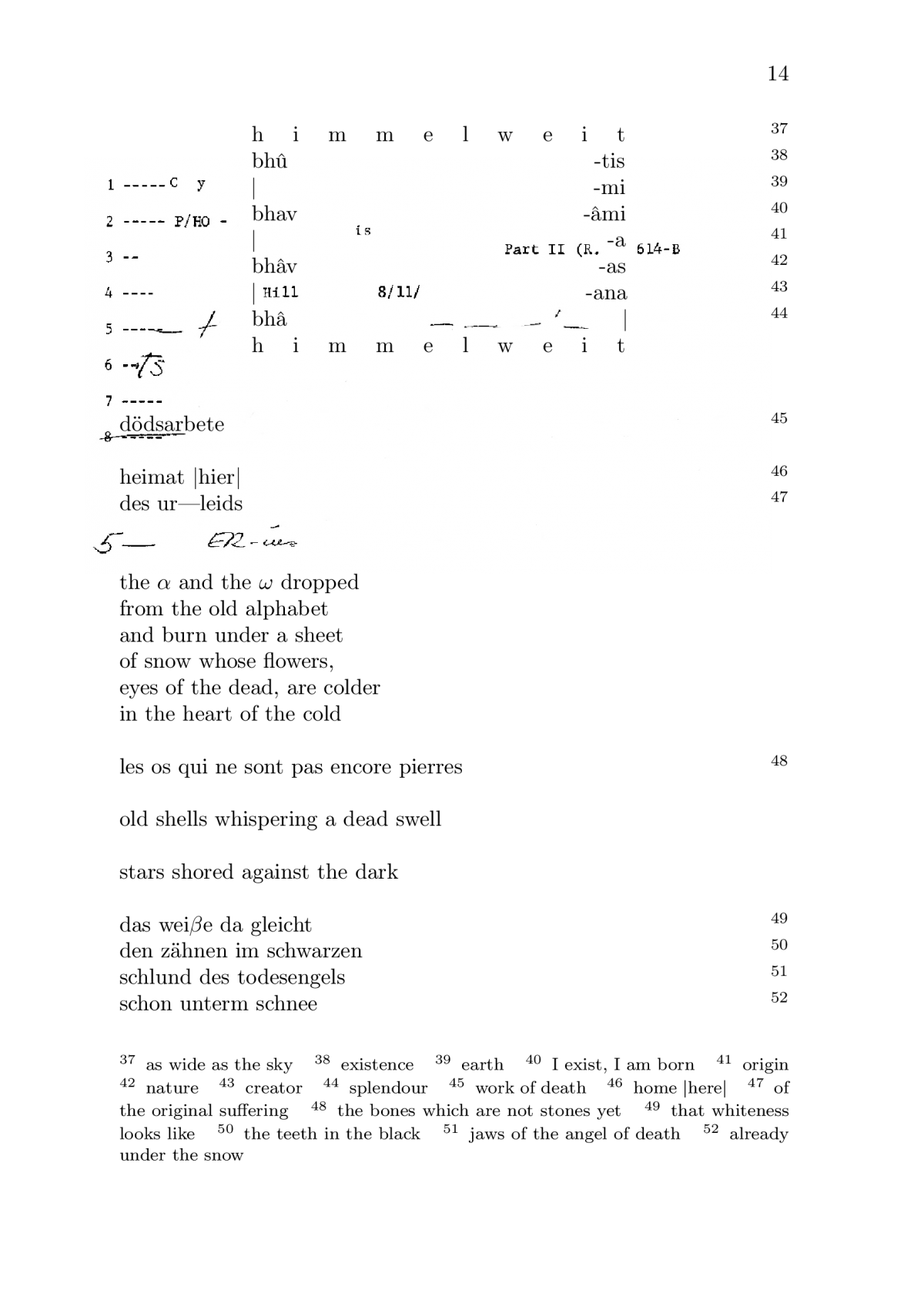
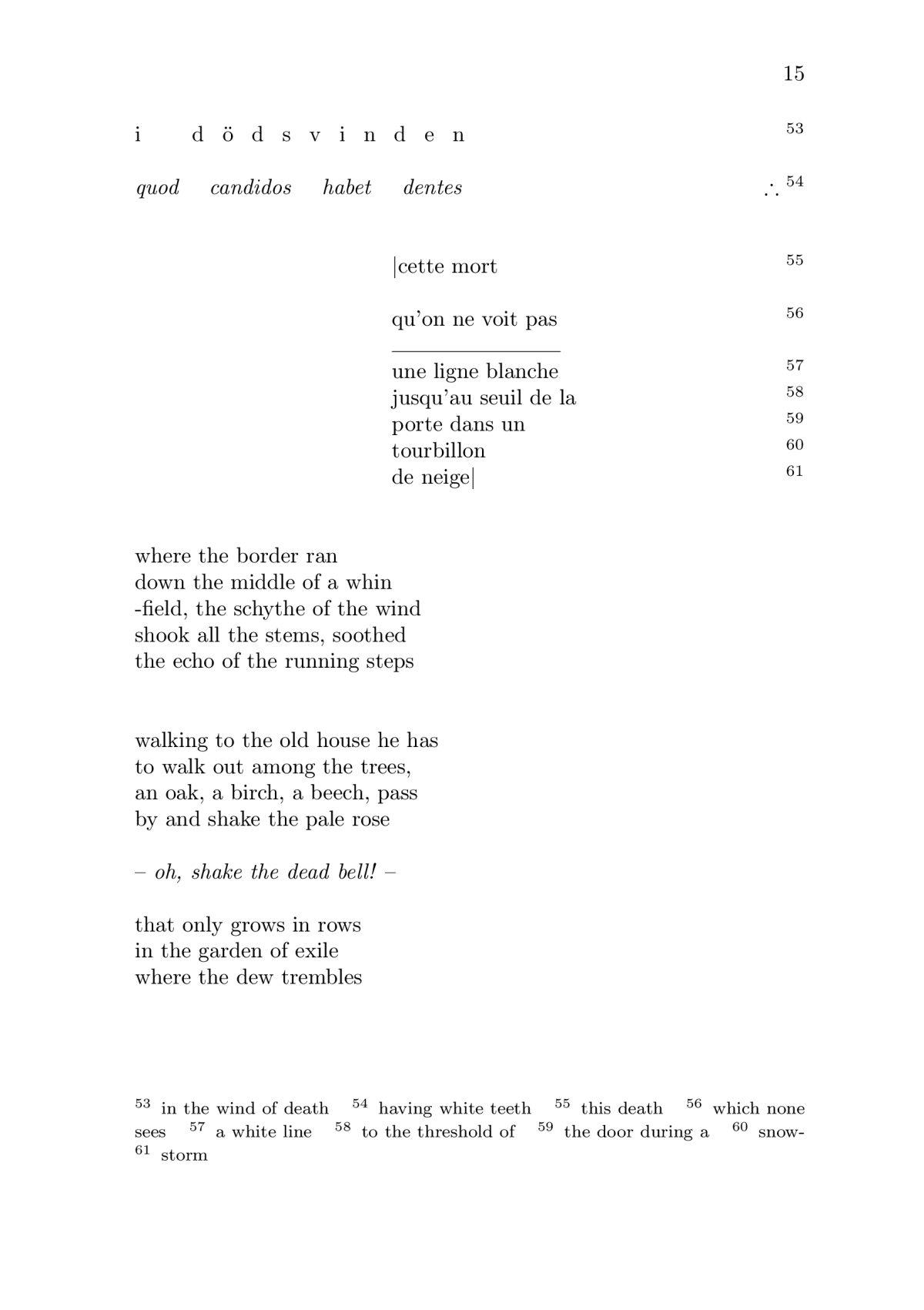
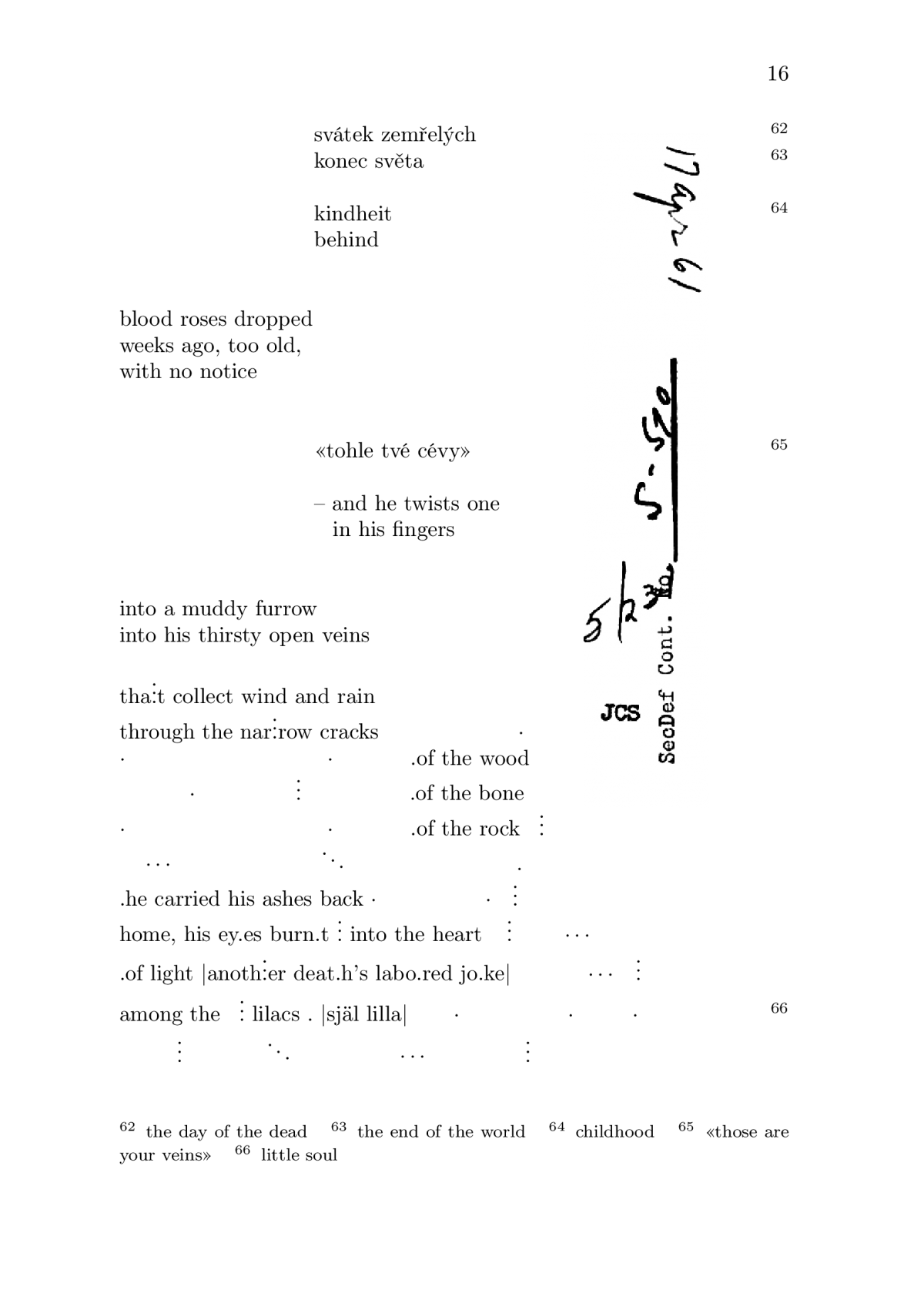

Digital and experimental poetry
Valikoima runoja monikielisestä visuaalisen runouden kokoelmasta E-IS.
Excerpts from the multilingual book of visual poetry E-IS.
“This excerpt consists of the first few pages of E-IS, a still unpublished work with a strong bent toward visual poetry. The trope of the text as an intrinsic combination of both sound and word structures is here achieved by different means: setting up whole blocks of text, sparse lines or split syllables; arranging tables of words; scattering residual scribbles, figures or short sentences, pointing to seemingly off topic documents. This results in the reader’s immersive experience of diving into some accreted language structure to unlock while being looked at and read, with no other way round. While in Requiem auf einer Stele (first ed. Conversation Paperpress 2010, second ed. Libri della Neve 2017) the sediment of different languages was embedded in the geology of a river stone, in E-IS the premise for it relies on the fissures of ice. Words into no matter which language physically weigh on a somehow transparent surface, «écran plastique de la représentation» (Louis Marin), whose crack lines, occurring in the very singularities of meaning, are often largely unpredictable. The reader and the writer get thus engaged in the same task.”
Julkaistu Nokturnossa 2019 | Published in Nokturno 2019







Videodokumentointi äänirunoutta ja tanssia yhdistävästä esityksestä. A Pile of Frames on jatkuvasti kehittyvä sanan, äänen ja liikkeen rakenteiden work-in-progress -projekti. Se sai alkunsa Saaren kartanon residenssissä vuonna 2014. Teos koostuu sarjoista lyhyitä, strukturoituja improvisaatioita. Huelstrunk ja Koistinen ovat esittäneet sitä Suomessa Helsingissä, Turussa, Mynämäellä ja Jyväskylässä sekä ulkomailla Frankfurtissa, Pariisissa ja Berliinissä.
A video from a performance combining dance and sound poetry. “A pile of frames” is a constantly evolving work-in-progress project, initiated in 2014 in Saari Residence, about word sound movement structures. It consists of a series of short, structured improvisations and has been presented in Frankfurt, Paris, Berlin, and in Finland in Helsinki, Turku, Mynämäki and Jyväskylä.
Ääni, teksti, ääniluupit | Voice, text, sound loops Dirk Huelstrunk
Tanssi ja koreografia | Dance ja choreography Milla Koistinen
Video | Video Bernhard Bauser (Gallus Theater), Antti Seppänen (Forum Box)
“Everything starts with the framework: some time, some space, some word, some sound, some body moving & breathing, repeating. A frame is an arbitrary boundary. The tongue touches the boundaries of the mouth. Sound touches the boundaries of sound. A movement touches the boundaries of the body. A body touches the boundaries of the room & space. A frame is the frame of another frame. A frame is a gesture. A frame is a possibility.”
Julkaistu Nokturnossa 2019 | Published in Nokturno 2019
Dirk Huelstrunkin ja Milla Koistisen haastattelu, aiheena runoutta ja tanssia yhdistävä teos A Pile of Frames (2014). Franziska Helmsin tekemä haastattelu on ilmestynyt alunperin saksaksi berliiniläisen Lettrétage-kirjallisuustalon sivustolla.
An interview with Dirk Huelstrunk and Milla Koistinen about their collaborative dance and poetry work A Pile of Frames (2014). Originally published in German on the website of Lettrétage Literature House. Interviewer Franziska Helms.
Videodokumentointeja teoksesta | A video documentations of the performance
Julkaistu Nokturnossa 2019 | Published in Nokturno 2019
Literaturhaus “Lettrétage”, Berlin, Feb. 2nd 2015
Franziska: Repetition plays an important role in your upcoming performance at Lettrétage. Can you explain the idea?
Dirk: I work with a so-called “Loop Station”, with which I can record and repeat my vocals live on three different tracks. I can also mix the tracks spontaneously. Repetition is one important element of our program. I see repetition as a fundamental aspect of life. It is the structure behind all activities and all technology. We are surrounded by repetition everywhere and I try to use this principle artistically. The interesting thing is that repetition is always something to do with structuring – but the more you structure, the more chaotic it can get in the end. There is a tipping point where repetition looses its structuring function and dissolves in chaos: The title “A Pile of Frames” refers to that phenomenon, as it imagines a heap of overlapping frames that become opaque in the end.
“We usually have this drive to move on, to always create something new and exciting. That makes it hard to restrain yourself and to maintain concentration. “
Milla: It is also an attempt to consciously stick to one thing. We are so used to fast cuts and change of perspective; always waiting for the next thing. It is also popular in dance, this tendency to present tricks that are as exciting as possible as quickly as possible in order to be entertaining. This makes it difficult to stick to a few simple elements and concentrate on them, but in the end it gets very complex. The further we go with the sound and the movements the repetition changes the character of our actions. This initial difficulty in sticking with the basic elements may be an experience that both we and the audience are sharing. Then, when you make small changes, and you realize how much is actually happening with the voice and the dance, it gets really interesting.
Dirk: We usually have this drive to move on, to always create something new and exciting. That makes it hard to restrain yourself and to maintain concentration. However, to create something new through repetition is very easy. Perception changes automatically. When I hear one and the same thing over and over again, at some point I will hear something else.
“The text is important in that it initiates associations.”
Franziska: How do you combine dance and sound elements in this performance?
Dirk: Our performance seems very reduced at first: there is no extra backdrop, no props or costumes. We try to concentrate on the pure movement and the pure sound. The text is important in that it initiates associations. Strange instructions, for example are one specific element. The topic of structure and framework is taken up by the words: you could imagine a bureaucratic framework, a waiting room of a doctor or a social welfare office, but you can also imagine something completely different. The text should be open enough to allow a range of ideas.
Milla: We have also agreed that the movements do not simply illustrate the text. It would be easy for me to go along with the text because it is so strong, but I try not to do that. I don´t like to show my own interpretation and thus narrow the audience’s freedom of association. I think it’s good that the lyrics are not that extensive. It’s usually easier to stick to words, but then the movement might become completely incomprehensible. Since there is no long story, there is space for the movement.
Dirk: In interaction, the sound and the rhythm of the words are connecting elements. Sometimes the focus shifts so that the meaning of the words becomes less important. The sound becomes the dominant feature.
“Working in front of an audience raises the energy level of the whole performance substantially. There are always new things happening.”
Franziska: You have already developed “A Pile of Frames” a year ago and have performed it many times. What do you think could be different at Lettrétage?
Milla: Of course, there are a few fixed elements, and we discuss and rehearse each performance, but improvisation is an important part and the result is never exactly the same. We also try to adapt our piece to the different performance spaces and atmospheres we encounter. Working in front of an audience raises the energy level of the whole performance substantially. There are always new things happening. The physical presence of the audience in small places is still something special for me. It is a different experience in a theatre room where the audience is usually far from the stage.
Dirk: And in every place we find a different audience. For example, I find it exciting to be able to confront people in a more literary space with sound and dance. This mixture of unusual places and unfamiliar audience is very exciting, especially since our piece is not easily definable in terms of genre. Theoretically it can be assigned to different genres. You can experience it as music, dance, text or even a literary project – it´s everything.
Kaksi artikkelia ja esimerkkirunoja neuroverkoilla generoidusta runoudesta, jonka lähteenä toimii olemassaolevien runoilijoiden tuotanto. Ensimmäinen artikkeli esittelee yleisimpiä haasteita, tutkimuksessa käytettyjä metodeja sekä sen monikielistä aineistoa ja lopputuloksia. Toinen keskittyy fonetiikkaan liittyviin kysymyksiin.
Two articles on author-stylized poetry generated with neural network plus two example poems. The first article addresses the question from the point of view of multilinguality and the second one addresses phonetical aspects of author-stylized poetry generated by a neural network.
1. Guess who? Multilingual approach for the automated generation of author-stylized poetry
2. Sounds Wilde – Phonetically extended embeddings for author-stylized poetry generation
Julkaistu Nokturnossa 2018 | Published in Nokturno 2018
Ivan Yamshchikov & Alexey Tikhonov
I Feel You: What makes algorithmic experience personal?
the time s to get closer to life
the time s to get closer to life
in and out of human faces
with you both in your own places
but its almost too cruel to try
the time s to get closer to life
the time s to get closer to life
i am and that is my mission
a whole new light in my vision
when a tear falls from the skies
the time s to get closer to life
the time s to get closer to life
i m just looking out and feeling
the tears they shed were not healing
and give them no power to write
the time s to get closer to life
* * *
At night I lay waiting for a
Interaktiivinen runo klikkikalastelusta.
An interactive poem inspired by the language and imagery of clickbait.
Konsepti | Concept Barnaby Smith & Michael Bloss
Teksti | Text Barnaby Smith
Suunnittelu ja toteutus | Design and development Michael Bloss
Kuvat | All photos Creative Commons.
“This work grew out of a discussion between the two of us about the nature and potential of electronic poetry, developing into a collaborative project based not only on the platforms and technical possibilities of the digital realm, but also its most unedifying language and visuals. Specifically, the work seeks to exploit the cynical and disposable headlines and imagery associated with ‘clickbait’, by creating a somewhat absurd, garish, but still meaningful generative poem. The poem takes shape according to which images the user is most drawn to, and then clicks on, in order to progress through (and generate) the poem. At the end of the sequence of images, a complete ‘chosen’ generated poem is revealed, along with the accumulated poetic path not taken by the user, as well as the entire text used for this poem.”
Julkaistu Nokturnossa 2018 | Published in Nokturno 2018